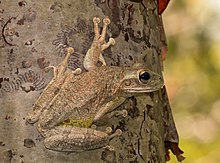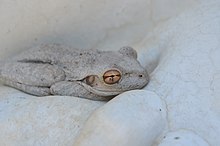
The cane toad, also known as the giant neotropical toad or marine toad, is a large, terrestrial true toad native to South and mainland Central America, but which has been introduced to various islands throughout Oceania and the Caribbean, as well as Northern Australia. It is a member of the genus Rhinella, which includes many true toad species found throughout Central and South America, but it was formerly assigned to the genus Bufo.

A frog is any member of a diverse and largely carnivorous group of short-bodied, tailless amphibians composing the order Anura. The oldest fossil "proto-frog" Triadobatrachus is known from the Early Triassic of Madagascar, but molecular clock dating suggests their split from other amphibians may extend further back to the Permian, 265 million years ago. Frogs are widely distributed, ranging from the tropics to subarctic regions, but the greatest concentration of species diversity is in tropical rainforest. Frogs account for around 88% of extant amphibian species. They are also one of the five most diverse vertebrate orders. Warty frog species tend to be called toads, but the distinction between frogs and toads is informal, not from taxonomy or evolutionary history.

Hylidae is a wide-ranging family of frogs commonly referred to as "tree frogs and their allies". However, the hylids include a diversity of frog species, many of which do not live in trees, but are terrestrial or semiaquatic.

The American green tree frog is a common arboreal species of New World tree frog belonging to the family Hylidae. This nocturnal insectivore is moderately sized and has a bright green to reddish-brown coloration. Commonly found in the central and southeastern United States, the frog lives in open canopy forests with permanent water sources and abundant vegetation. When defending its territory, the frog either emits aggressive call signals or resolves to grapple with intruders, seldom leading to injury or death. To avoid predation, the frog will leap into the water or jump into the treetops.

The banded bullfrog is a species of frog in the narrow-mouthed frog family Microhylidae. Native to Southeast Asia, it is also known as the Asian painted frog, digging frog, Malaysian bullfrog, common Asian frog, and painted balloon frog. In the pet trade, it is sometimes called the chubby frog. Adults measure 5.4 to 7.5 cm and have a dark brown back with stripes that vary from copper-brown to salmon pink.

The gray treefrog is a species of small arboreal holarctic tree frog native to much of the eastern United States and southeastern Canada.

The squirrel tree frog is a small species of tree frog found in the south-eastern United States, from Texas to Virginia. This is an introduced species in the Bahamas. Squirrel tree frogs are small frogs, about 1.5 inches in length as adults. There are several color variations, but most commonly they are green and look very much like the American green tree frog. They can also be varying shades of yellow or brown, sometimes with white or brown blotching.
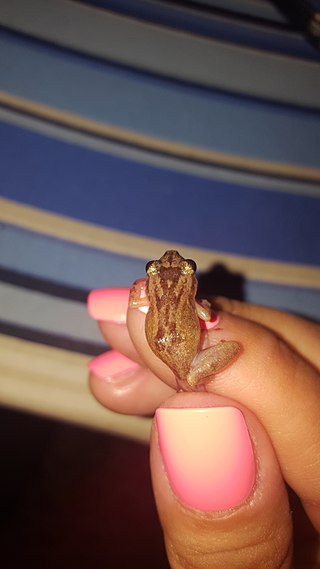
The whistling coquí, Cochran's treefrog, or Cochran's robber frog is a species of frog native to Puerto Rico, the US Virgin Islands, and the British Virgin Islands. This nocturnal insectivore is also referred to as the coquí pitito in Puerto Rico. Their distinctive song is a single, rising whistle, which is repeated and followed by three clicking sounds.
Coquí is a common name for several species of small frogs in the genus Eleutherodactylus native to Puerto Rico. They are onomatopoeically named for the very loud mating call which the males of two species, the common coqui and the upland coqui, make at night. The coquí is one of the most common frogs in Puerto Rico, with more than 16 different species found within its territory, including 13 in El Yunque National Forest. Other species of this genus can be found in the rest of the Caribbean and elsewhere in the Neotropics, in Central and South America. The coquí is an unofficial national symbol of Puerto Rico; there is a Puerto Rican expression that goes, "Soy de aquí, como el coquí", which translates to "I'm from here, like the coquí."

Dryophytes gratiosus, commonly known as the barking tree frog, is a species of tree frog endemic to the south-eastern United States.
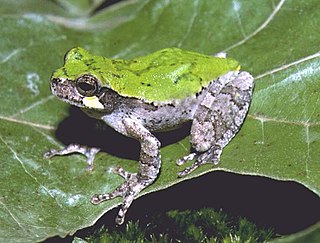
The bird-voiced tree frog is a species of frog in the family Hylidae, endemic to the United States. Its natural habitats are temperate forests, shrub-dominated wetlands, and swamps.
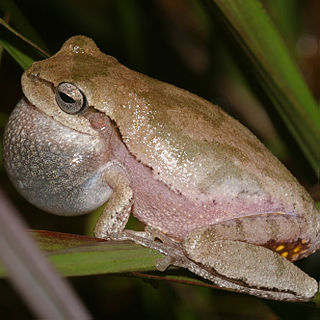
The pine woods tree frog is a species of frog in the family Hylidae, endemic to the southeastern United States.

The green-eyed treefrog is a species of Australasian treefrog in the subfamily Pelodryadinae that occurs in the Wet Tropics of Australia.
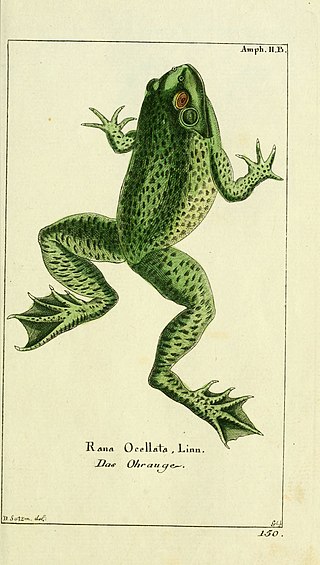
The Jamaican laughing frog is a species of frog in the family Hylidae. It is endemic to Jamaica. Other common names include Savanna-la-Mar treefrog.

The red-eyed coqui, churi, coqui churi, or coqui de las Antillas is a species of frog in the family Eleutherodactylidae that is found in Puerto Rico, the British and U.S. Virgin Islands, and introduced to Panama. Although there are many similar species that are endemic to these tropical locations, its unique physical, habitual, and behavioral characteristics distinguish it from other members of the genus Eleutherodactylus. This genus contains around 185 species that are located in the southern United States, Central America, South America, and the Caribbean, with 16 different species endemic to Puerto Rico. The red-eyed coqui was not brought into Panama City from its native habitats until the late 1960s. There it became established in urban parks before it began to colonize outside the city in the 1980s. In Puerto Rico, the largest island inhabited by the red-eyed coqui, it is found up to 1,200 meters above sea level. It is often compared to the common coqui, Puerto Rico's unofficial territorial symbol, but upon a closer ecological look, the red-eyed coqui has many differences.

A tree frog is any species of frog that spends a major portion of its lifespan in trees, known as an arboreal state. Several lineages of frogs among the Neobatrachia suborder have given rise to treefrogs, although they are not closely related to each other.

